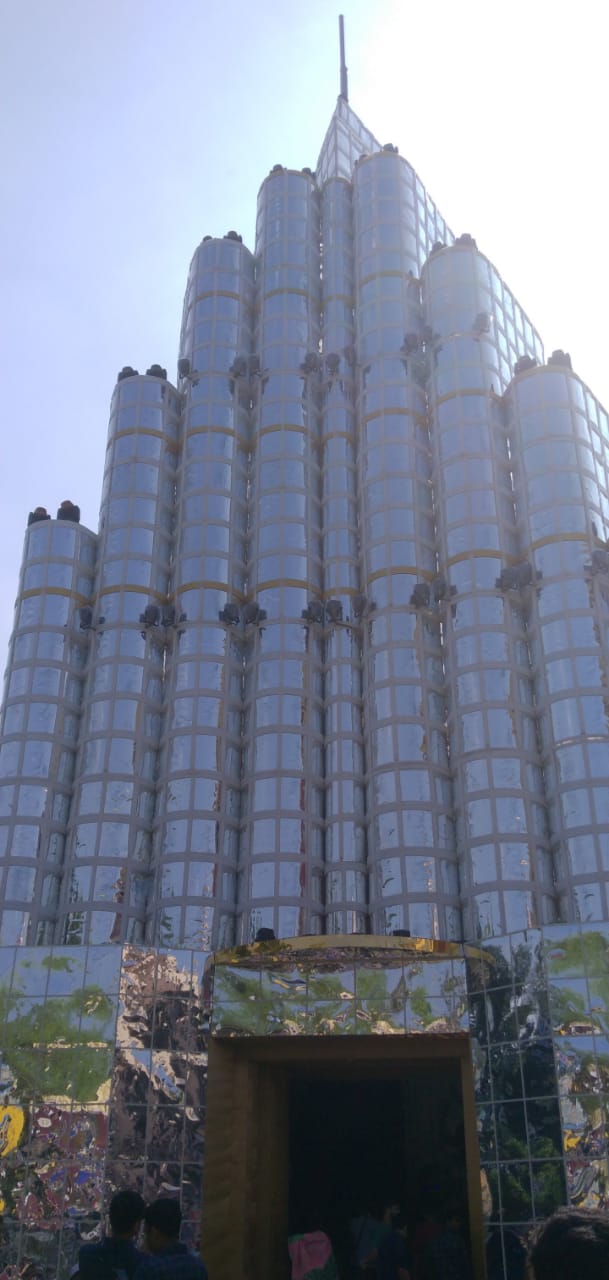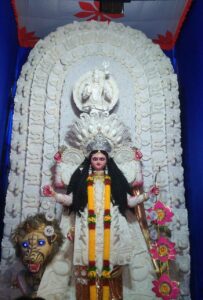Some even claim that Kolkata is the cultural hub of India’s Bengal region. It is said that whatever occurs in Kolkata is a reflection of Bengal. In every event that ever takes place in the state, the huge city steals the show. The Bengali calendar of holidays kicks off with Durga Puja and ends with the countdown to the following year’s celebration. Kolkata is once again in charge here. Millions of visitors are enthralled by the traditional Durga Puja of Sovabazar Rajbari, the Rani Rashmoni family of Janbazar, the Sabarna Roychowdhurys, the Daws, the Mallicks, and the modern theme pujas with their creative variations in pandals, lights, and idols. To argue that the Durga Pujas in Kolkata are a billion dollar industry in and of itself would not be an exaggeration. The hierarchy does, however, occasionally temporarily reverse itself in the late fall. About a month after the Durga Pujas are over, it occurs. People believe that the lengthy holiday season is officially gone after Diwali. But now, in Chandernagore—a former French colony in Bengal’s Hooghly district, just 40 kilometres from Kolkata—the grandest of all festivities is about to begin. When the five-day Jagadhatri Puja celebrations begin, Kolkata is cast in the shadow of this ordinarily tranquil mufassil town on the west bank of the Hugli River.
The intensity and devotion with which individuals participate in this celebration is a clear indication of the soul connection. For many centuries, this has been the case. Some people had doubts about the post-merger environment and Chandernagore’s future as a tiny town in India after 1952. But they undoubtedly ignored the strength of human emotion. It is emotionally connected to a strong feeling of ingrained tradition, which was important in giving Chandernagore a new identity and saving it from possible annihilation. On August 15, 1947, the rest of India became independent from the British; nevertheless, Chandernagore remained a French colony. The De Jure Transfer Treaty was signed by the French and Indian governments on February 2, 1951, and it was approved by the French National Council on April 11, 1952. The De Facto Transfer Treaty was signed on May 2, 1950. On September 29, 1954, the Merger Pact was accepted, and on October 2, 1954, Chandernagore was officially amalgamated with the state of West Bengal. The town charmed the world with two of its most distinctive legacies—the Jagadhatri Pujas with their renowned illumination skills and their sweets—while accepting its former splendour and the departure of the French.
With the history of the Jagadhatri Pujas in Chandernagore, there is no trustworthy historical evidence. According to popular belief, Dewan Indranarayan Chowdhury, a French courtier and close friend of Raja Krishnachandra of Nadia, established the custom of goddess worshipping in this location. This, however, cannot be the case since Dewan Indranarayan Chowdhury went away in 1756, a considerable time before it is believed that the Raja of Nadia began it. That was in 1762, when the Raja was freed from Nawab Mir Qasim’s imprisonment in Murshidabad and told how the goddess Jagadhatri had appeared to him in all of her splendour and urged him to worship her because he had missed the Durga Puja

. What might have actually happened is that Maharaja Krishnachandra, just as he had done for the Annapurna Pujas, set up a network of dependable officials and provided them with financial support to disseminate this “new” form of mother goddess worship throughout Bengal. But it’s hardly “new,” as there is proof of prior devotion of this martial version of the goddess Durga in several locations, including Hetampur, Shantipur, Nanoor, and Barishal (now in Bangladesh).
The Top Associates

PC tania Mukherjee
The two West Bengal cities most famous for their devotion to this deity are Chandannagar and Krishnanagar (Nadia District) (Former French Colony, Hooghly District, a small town, 30 kilometres north of Kolkata).
These cities are unique because of their splendour and reputation.
Even though Chandannagar today displays considerably greater splendour during this Puja, Krishnanagar has a unique historical significance for the inception of Jagadhatri Puja.
Public worship of the goddess Jagaddhatri is credited to Krishnachandra Ray, the raja of Krishnanagar in the Nadia District.
Siraj, the emperor in authority at the time, once imprisoned Raja Krishnachandra for failing to pay taxes.
He was returning to Nadia from Murshidabad by boat for the autumn Durga Puja when he was released from jail.
As a committed follower of Durga, he was saddened to have missed the celebrations when he heard the sound of the drums, which signalled that it was the tenth or last day of the puja.
Later that evening, he saw a vision of the goddess Durga as a small child.
In order to gain the same blessings from her, she told him to worship her on the ninth day of the bright fortnight in the month of Kartik.
Later, while he was discussing this incident with the family priest, he learned that this was, in fact, the goddess Jadadhatri.
A statue of the goddess Jagaddhatri was ordered by Krishnachandra from a artisan, and at the appointed hour he conducted an elaborate worship service for it.
The Devi Description
In contrast to Devi Durga, Jagadhatri Devi is not worshipped alongside Laxmi, Saraswati, Kartik, or Ganesh. Present are only Jaya and Vijaya.
Since Goddess Jagadhatri is portrayed in Tantra and Purana as having the colour of the morning sun, three eyes, four arms, a conch and a bow in her two left hands, a chakra and a five-headed arrow in her two right hands, and riding a lion, the idol is made similarly to that of Goddess Durga.
The conch denotes brilliance and purity; the chakra extinguishes evil spirits, the arrow/shaft wisdom, and the bow concentration. Thus, according to the Hindu calendar, the Goddess establishes the auspicious period and delivers the spirit of wisdom.
She is trapped by a snake around her neck, in contrast to Devi Durga, which symbolises overcoming all obstacles in life. The goddess’s idol is exquisitely decorated with red clothing and decorations. A neck garland is given to the deity.
That crown is still in use today and has been used in other pujas as well. When the middle class began to emerge at the end of the 19th century, they took the pujas out of the stately homes and gave them their current Barwari form, where anybody in the neighbourhood can participate. Therefore, contrary to what the general public seems to believe, the Chandernagore Jagadhatri Puja is just about 250 years old at most. The enormous idol with its wide-open eyes and four hands holding a conch, a discus, a shaft, and a bow has never failed to awe onlookers throughout the ages. Like Durga, the goddess is mounted on a lion, but unlike Durga, an elephant that has been killed lies at the goddess’s feet. The demon Karindrasur, who was slain by the goddess Jagadhatri, a combative manifestation of goddess Durga, is represented by the elephant. Her neck is adorned with a snake that represents the sacred thread (poitey) worn by Brahmins. She truly manifests as the genuine Jagadhatri, the protector of the planet, as people bow in adoration and wonder before her.
The Jagadhatri Pujas have changed over time and are now more than just an act of worship. It is an elaborate show that lasts for five days (unlike Krishnanagar, where it is held for a single day). The village is transformed into a true Neverland of dreams with enormous idols that are richly jewelled (there are no fake jewels here; everything is real gold and silver), “theme” pandals, and the renowned lighting techniques. Thousands of people swarm there. The iconic procession of immersion on the fifth day marks the culmination of the event. The parade was designed by the French to go around the town in a circle, and it still takes that same path today.
According to business estimates, during the Durga Pujas in Kolkata, there are almost three lakh footfalls each day per pandal. According to Chandernagore Corporation sources, the nightlong procession of immersion attracts over ten lakh people to Chandernagore on the last day of the pujas. Ten to fifteen lakh more people attend the puja throughout the remaining four days. All of these figures combine to form the story of Chandernagore, which its citizens carefully protect from any outside influence that, in their opinion, could damage their revered traditions. Any plans to hold a Jagadhatri Puja festival in Chandernagore had to be abandoned because locals were concerned that it would dilute the significance of the immersion procession’s 64-year-custom. For them, a carnival is not a passive designer event; rather, it is Chandernagore’s own procession, during which tens of thousands of spectators spend the night on the Strand by the river to see the display of idols hauled by enormous trucks and the extravaganza of lights.